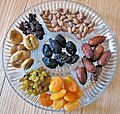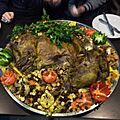Iraqi cuisine facts for kids
Iraqi cuisine (also called Mesopotamian cuisine) is a type of Middle Eastern cuisine. Its roots go back to ancient civilizations like the Sumerians, Akkadians, Babylonians, and Assyrians. These groups lived in the region now known as Iraq.
Ancient clay tablets found in Iraq show some of the world's first cookbooks. These tablets contain recipes prepared in temples for religious festivals. Ancient Mesopotamia was a very advanced civilization. They were skilled in many areas, including cooking!
Iraqi cooking became even more amazing during the Islamic Golden Age. At that time, Baghdad was the capital of the Abbasid Caliphate (from 750 to 1258 AD). Over time, Iraqi food has been influenced by its neighbors. These include Greek cuisine, Persian cuisine, and Turkish cuisine. Today, Iraqi food still shows this rich mix of traditions.
Food in Iraq changes from one part of the country to another. In Northern Iraq, cooks often add pomegranate juice to dolma for a special taste. Southern Iraq uses a lot of fish in its dishes. The central region, around Baghdad, is famous for its many rice dishes and delicious sweets.
Modern Iraq is naturally divided, much like ancient Mesopotamia. The northern part, called Assyria, is dry and hilly. It grows wheat and fruits like apples. The southern part, called Babylonia, has fertile plains. It grows rice, barley, and citrus fruits. Iraq is also one of the world's biggest producers of dates.
Contents
A Taste of History: Ancient Iraqi Food
Archaeologists have found exciting clues about ancient Iraqi food. For example, at a place called Jarmo in northeastern Iraq, they found pistachio nuts from as early as 6750 BC! This shows people were eating them a very long time ago.
Around 1900 BC, a special dictionary was written on 24 stone tablets. It listed over 800 different food and drink items in two ancient Iraqi languages. Imagine, it included 20 types of cheese, over 100 kinds of soup, and 300 types of bread! Each had different ingredients, shapes, or sizes.
The world's oldest known recipes come from ancient Iraq. These recipes are written on cuneiform clay tablets from 1700 BC in Babylon. One tablet has 24 recipes for stew made with meat and vegetables. They used ingredients like leeks, onions, garlic, and spices such as cumin and mint. Stews are still a very important part of Iraqi cooking today.
What Makes Iraqi Food Special?
Key Ingredients
Iraqi cuisine uses many fresh and flavorful ingredients. Here are some common ones:
- Vegetables: You'll find eggplant, tomatoes, turnips, shallots, okra, onions, lentils, potatoes, zucchini, spinach, garlic, and peppers.
- Grains: Rice is a staple, especially a fragrant type called timman anbar. Bulgur wheat and barley are also very common.
- Legumes: These include lentils, chickpeas, green beans, and cannellini beans.
- Fruits: Olives, dates, raisins, apricots, plums, figs, grapes, melons, pomegranates, and citrus fruits like lemons are all used.
- Cheeses: Types like baladi, feta, and halloumi are popular.
- Herbs and Spices: Cinnamon, cardamom, coriander, cumin, mint, saffron, turmeric, and sumac add amazing flavors.
- Nuts and Seeds: Sesame, pistachios, almonds, walnuts, and pine nuts are used in many dishes.
Other important items in Iraqi cooking are olive oil, tamarind, tahini (sesame paste), honey, date syrup, yogurt, and rose water.
Lamb is a favorite meat, but chicken, beef, goat, and fish are also eaten. Most meals are served with rice. Flatbread is also a staple, served with dips, cheeses, and jams at every meal.
Appetizers and Dips (Mezza)
Meals in Iraq often start with appetizers and salads. These are known as mezza. Mezza is a selection of small dishes. They are often served with a drink, similar to tapas in Spain.
Some popular mezza dishes include:
- Iraqi sumac salad: A typical Iraqi salad with the addition of sumac berries.
- Baytinijan maqli: Fried eggplant served cold with tahini, lettuce, parsley, and tomatoes. It's often garnished with sumac.
- Fattoush: A salad made from fresh vegetables and toasted or fried pieces of pita bread.
- Tabbouleh: A salad with finely chopped parsley, bulgur, mint, tomato, and other herbs. It's dressed with lemon juice and olive oil.
- Turshi: Pickled vegetables, a traditional appetizer in many Middle Eastern countries.
Common dips include:
- Baba ghanoush: A dip made from baked eggplant, mashed and mixed with seasonings.
- Hummus: A popular dip made from cooked, mashed chickpeas, blended with tahini, olive oil, lemon juice, salt, and garlic.
- Tzatziki: A creamy dip made from strained yogurt with cucumbers, garlic, salt, and usually olive oil.
Hearty Soups and Stews
Stews served over rice are a big part of Iraqi cooking.
- Fasolia yabsa: An Iraqi white bean stew with tender lamb or veal and tomato sauce.
- Fasoulia: A soup made from dry white beans, olive oil, and vegetables.
- Harissa: A porridge-like dish made of stewed chicken and coarsely ground wheat.
- Kebabs: Grilled meats on a skewer, usually lamb or beef, but also chicken or fish.
- Lentil soup: Can be vegetarian or include meat, made with different types of lentils.
- Maqluba: An "upside-down" rice and eggplant casserole. It often includes braised lamb.
- Margat bamia: A stew made with okra and lamb or beef cubes in a tomato sauce.
- Margat baytinijan: An eggplant-based dish, usually with sautéed eggplant, tomato, and minced meat.
- Masgouf: A traditional dish with fish from the Tigris river. The fish is roasted for hours after being marinated. It's served with lemon, chopped onions, tomatoes, and flatbreads.
- Pomegranate soup: Called shorbat rumman, made from pomegranate juice, split peas, ground beef, and mint.
- Qeema: A minced meat, tomato, and chickpea stew, served with rice. It's traditionally made during Ashura celebrations.
- Quzi: Stuffed roasted lamb.
- Hikakeh: A thin, crispy crust of browned rice found at the bottom of the cooking pot.
- Tashrib: A soup made with lamb or chicken. Iraqi nan bread is broken into pieces and the soup is poured over it.
- Tepsi baytinijan: An Iraqi casserole with sliced and fried eggplant, lamb or beef, tomatoes, onions, and garlic. Potato slices are placed on top before baking. It's usually served with rice.
Dumplings and Meatballs
- Dolma: Stuffed vegetable dishes. Grape leaves are common, but zucchini, eggplant, tomato, and pepper are also used. The stuffing can include meat or be vegetarian.
- Falafel: Fried balls or patties made from spiced chickpeas or fava beans. It's a popular fast food and mezze item.
- Kofta: Meatball or meatloaf dishes. They are usually balls of minced meat (beef or lamb) mixed with spices and onions.
- Kubba: A dish made of burghul (cracked wheat), chopped meat, and spices. There are many types, including fried torpedo-shaped ones and baked or poached varieties.
- Samosa: A small fried or baked pastry, often half-moon or triangular, with various fillings.
Popular Rice Dishes
Long-grain rice is a very important food in Iraq. Iraqi rice cooking is special, aiming for tender, fluffy grains. A unique part of Iraqi rice cooking is the hikakeh, a crispy bottom crust. This crust is broken into pieces and served with the fluffy rice.
- Dolma: Vine leaves stuffed with a mixture of ground lamb or beef and rice. North Iraqis often add pomegranate juice for a unique taste. Iraqi dolma is usually cooked and served in a tomato-based sauce.
- Biryani: A flavorful rice dish made with spices, rice (often basmati), and meat or vegetables. It's popular in Iraq and many other countries.
- Mutabbaq samak: Fried fish served over seasoned rice.
- Pilaf: A rice dish similar to those found in Iran.
- Quzi: A rice-based dish served with very slow-cooked lamb, roasted nuts, and raisins.
- Tibeat: A Jewish-Iraqi dish, slow-cooked chicken stuffed with rice, tomatoes, dried apricots, and raisins, with a strong cardamom flavor.
Sandwiches and Wraps
- Shawarma: A Middle Eastern sandwich-like wrap. It usually has shaved lamb, chicken, or beef. Shawarma is a popular fast food across the Middle East.
Dairy Products
- Baladi cheese: A soft, white cheese from the Middle East with a mild flavor.
- Geimar: A creamy dairy product, like clotted cream, often made from water buffalo's milk.
- Jameed: Hard, dry labneh (strained yogurt) made from sheep's milk.
- Jibneh Arabieh: A simple cheese found throughout the Middle East, similar to feta but less salty.
- Labneh: Yogurt that has been strained to remove water, making it thicker and tangier.
Breads and Pastries
- Burek: A type of baked or fried pastry made with thin, flaky dough. It's filled with salty cheese, minced meat, or vegetables.
- Ka'ak: Refers to different types of baked goods found across the Arab world.
- Kahy: Layers of thin dough, often eaten warm for breakfast with creamy kaymak and light sugar syrup.
- Khubz Iraqi: An Arabic flatbread that is a common part of the diet in many Western Asian countries.
- Laffa: An Iraqi pita or naan bread.
- Lahmacun: A thin pizza topped with minced meat and herbs.
- Lavash: A soft, thin flatbread.
- Manakish: A pizza-like dish with dough topped with thyme, cheese, or ground meat.
- Markook: A very thin, large flatbread, often baked on a special domed griddle.
- Pita: A family of round flatbreads made from wheat flour.
- Samoon: A flat and round bread.
- Sfiha: Open-faced meat pies, traditionally made with ground mutton.
Sweet Treats
The oldest known recipe for cake comes from ancient Mesopotamia! These early cakes were likely for palaces or temples. They were made from fat, white cheese, dates, and raisins. Another recipe from around 1700 BCE included grape syrup, figs, and apples.
Traditional Iraqi kleicha cookies are thought to come from ancient Mesopotamian qullupu. These were date-filled pastries baked in a wood-fired oven called a tannour. Today, other cookies and cakes are made at home, often flavored with cardamom or rose water.
Cookbooks from the Abbasid Caliphate (10th to 13th centuries) had hundreds of dessert recipes. Rich, syrupy desserts like baklava are usually saved for special occasions or religious celebrations. Daily meals often end with fresh seasonal fruit, especially dates, figs, and melons.
Zalabia, which are rosette-shaped fritters, are a local specialty. They are believed to be named after Ziryab, a famous Kurdish-Iraqi musician. Baklava and zalabia are often served during the Eid al-Fitr celebrations after Ramadan. Halqoum (also known as Turkish delight) are traditional gifts during holidays.
Other sweets include:
- Halva: A sweet treat popular in many regions. It's mainly made from sesame butter (tahini) and sugar or honey.
- Kanafeh: A pastry with layers of semolina, white cheese, and a sugary syrup with rose water.
- Luzina: A candy similar to Turkish Turkish delight, made from ground fruits.
- Qatayef: An Arab dessert for the Muslim holiday of Ramadan. It's a sweet crêpe filled with cheese or nuts.
Refreshing Beverages
Non-alcoholic Drinks
- Coffee: A strong and bitter drink, very popular in Iraq.
- Sharbat: A chilled, sweet drink made from fruit juice or flower petals.
- Shinēna: A cold drink of yogurt mixed with cold water, sometimes with a pinch of salt or dried mint.
- Tea: Also known as chai, tea is widely consumed throughout the day. It's especially popular in the mornings, after meals, and during social gatherings. Iraqi tea is often brewed with cardamom.
Related Cuisines
Iraqi cuisine shares many similarities with other food traditions in the region. These include:
- Kurdish cuisine
- Armenian cuisine
- Assyrian cuisine
- Azerbaijani cuisine
- Caucasian cuisine
- Central Asian cuisine
- Iranian cuisine
- Levantine cuisine
- Mediterranean cuisine
- Middle Eastern cuisine
- Turkish cuisine
Images for kids
See also
 In Spanish: Gastronomía de Irak para niños
In Spanish: Gastronomía de Irak para niños


















